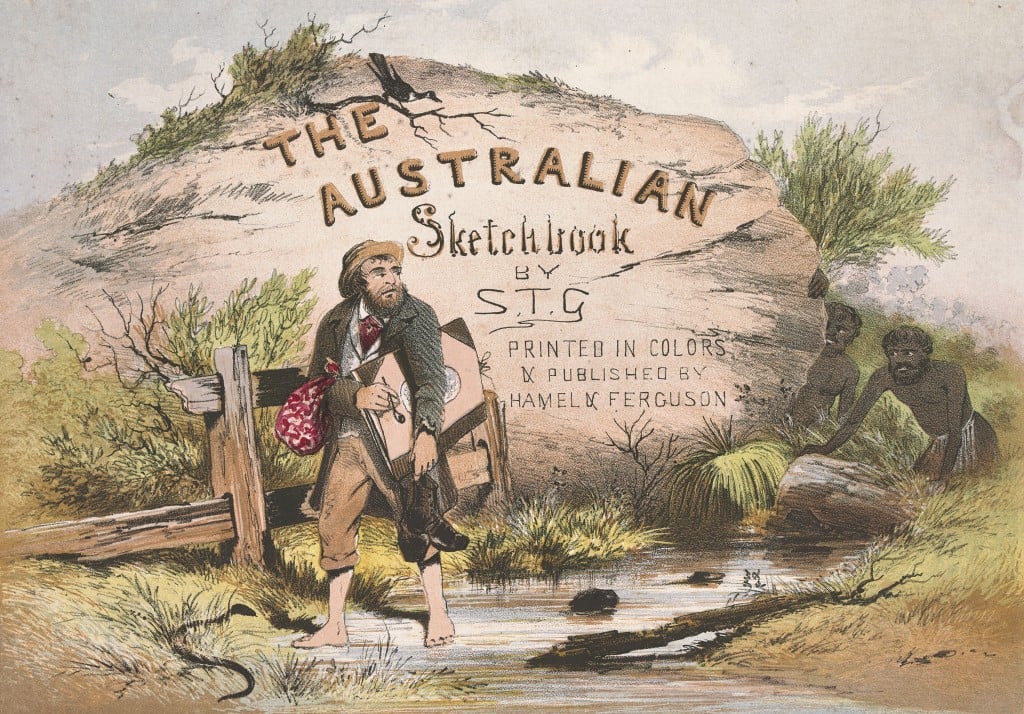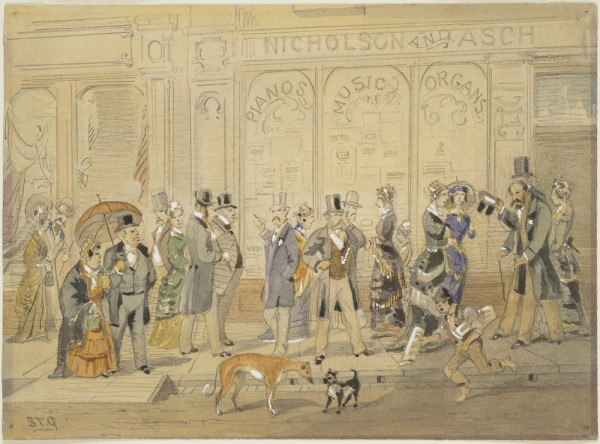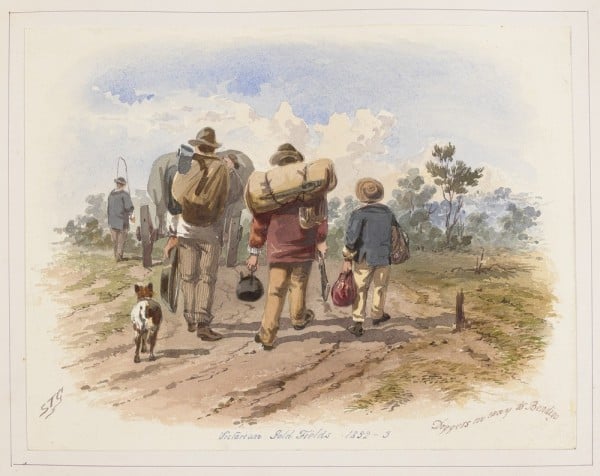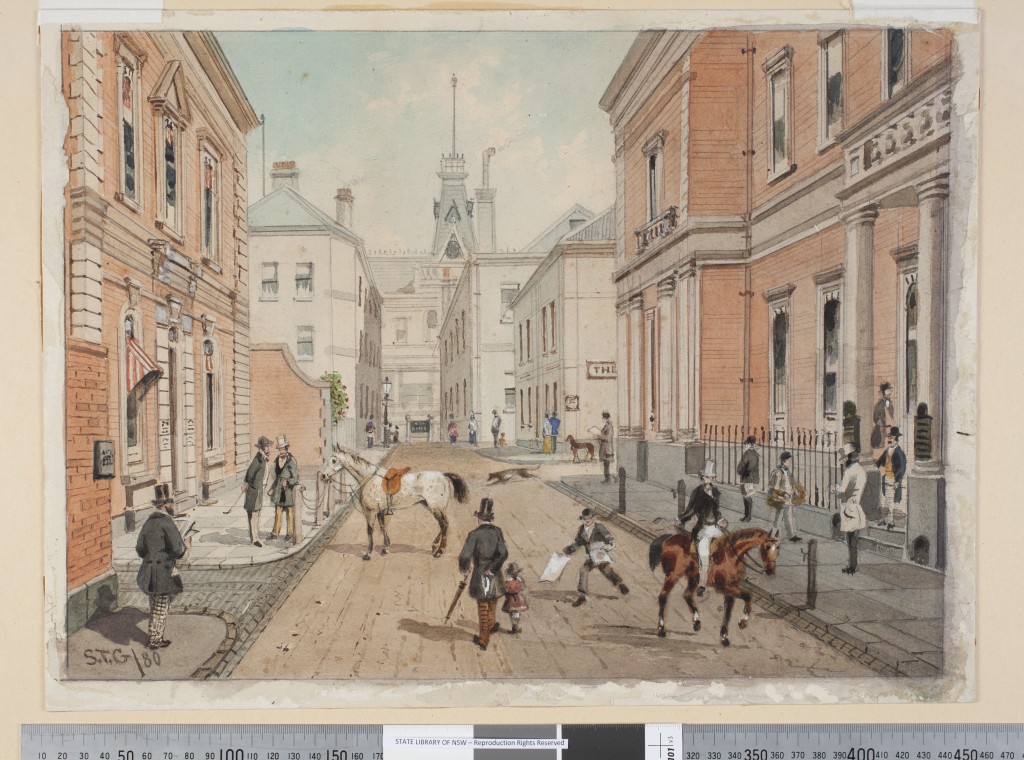In this special guest post, curator Sasha Grishin introduces ST Gill, the artist at the centre of our new exhibition, Australian sketchbook: Colonial life and the art of ST Gill.

ST Gill, Title page, The Australian Sketchbook by STG, 1864–65, chromolithograph, State Library Victoria
Shortly it will be the 200th anniversary of Samuel Thomas Gill’s birth in Somerset in England. STG, as he was universally known, died unrecognised on the steps of the GPO in Melbourne in 1880. Although he had been in Australia for over 40 years and was once Victoria’s most famous colonial artist, no obituaries were published at the time of his death and his centenary passed equally unnoticed. He was buried at public expense, without a headstone, in an unmarked grave, together with other paupers.
About a century ago an attempt was made to explain this neglect in terms of a character flaw in the artist, it was said that he had become a hopeless alcoholic and was incapable of producing work of calibre in the final decade of his life. This was a furphy. Gill got better as he got older and his best art, such as the iconic Doing the Block, Great Collins Street, was done in the final year of his life. Apart from that, he died at the age of 62 of a ruptured aorta, a heart attack, which had nothing to do with an alleged obsession with the ‘demon drink’. So why did Gill really fade from favour?
I think the answer is much simpler. STG became, with time, the conscience of colonial society and a thorn in the side of the establishment. He was a supporter of the Koori people, whom he showed as dispossessed and alienated in their own country. He was a tree-hugger, an environmentalist, who loved the bush and protested at the destruction of the flora and fauna in the frenzy of digging for gold. He denounced fanatical politicians who whipped up hysteria in the media about boat people from Asia stealing our jobs and our gold and was generally critical of the establishment and of institutionalised religions.
He also for the first time gave visual form to a new type of person – the Aussie digger – tough, resilient and resourceful, one who was true to his mates and denounced all forms of official humbug. Also, he depicted the tough Aussie women, who were not interested in dainty feminine pursuits, but rocked the cradle to extract the gold and ran the sly grog tents.
Gill’s vision of Australia was one of gritty realism with a republican and socialist orientation. While in his early years in Australia he was making art for those in the ‘old country’, by the time he established himself in Victoria, at the height of the gold rushes and the establishment of Marvellous Melbourne, his audience had become Australian.
By the 1870s colonial taste had changed in favour of stylish oil paintings of landscapes and the local audience no longer wished to be reminded of the turmoil on the goldfields and of the dark side of the colonial social fabric. Like their predecessors who wished to forget their convict past, many Australians did not want to be reminded of the source of their wealth.
This is the first major retrospective exhibition of the multifaceted art of STG, which is being shown in all of its beauty, humour and profundity in a unique display at the State Library Victoria with satellite exhibitions throughout the regional centres of Gill country.
Like no other colonial artist, Gill recorded the experience of what it was to be an Australian, now this historic exhibition for the first time reveals the subtle genius of Gill. Australian sketchbook: Colonial life and the art of ST Gill opens Friday 17 July. Presented in partnership with the National Library of Australia, it is complemented by a new publication, and a program of free curator talks, guided tours and lectures.





S T Gill exhibition excellent, perhaps we now need a contemporary social commentary exhibition say Oslo Davis!
Hi Sylvia, thanks for visiting the exhibition! Definitely food for thought…we have purchased some of Oslo Davis’ cartoons for the Pictures Collection:
http://handle.slv.vic.gov.au/10381/87349
And his publication ‘Libraryland’ was created after his 2010 Creative Fellowship here at the Library:
http://search.slv.vic.gov.au/MAIN:SLV_VOYAGER2502607
ST Gill certainly wrote my favourite books and artwork from the goldfields.
In fact my whole view of what the gold rush looked like is shaped through his art.
“it was said that he had become a hopeless alcoholic ”
This was no furphy, as Sarah Kelly claims. He could still paint to the end, but his hand shook so badly he had great difficulty…
also, court and other records show he was an inveterate drunk…